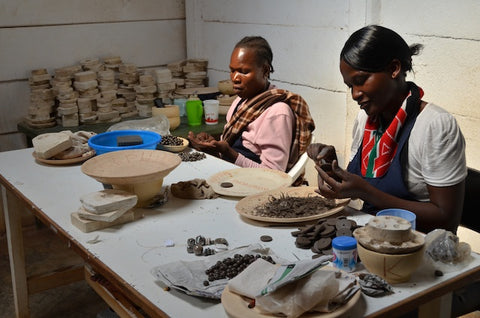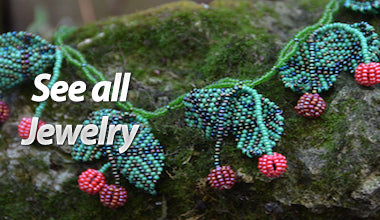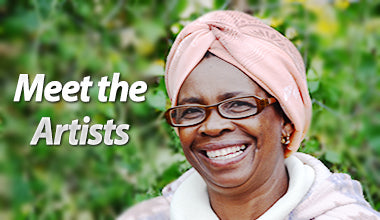Discovering Ceramics on the Outskirts of Nairobi, Kenya
 It seems like just last week that I flew home from my last trek to Africa, but it’s been a few months already! Back in September 2014, right before the craziness of the holiday season here in Tampa, I took off on another adventure to Africa and in addition to South Africa and surrounding areas - this trip included Kenya!
It seems like just last week that I flew home from my last trek to Africa, but it’s been a few months already! Back in September 2014, right before the craziness of the holiday season here in Tampa, I took off on another adventure to Africa and in addition to South Africa and surrounding areas - this trip included Kenya!
I had been dreaming about a Kenya adventure for years, but on this visit I had to make a choice; listen to the US State Department warnings about the risks for Americans traveling to Kenya, or ignore those warnings and trust that my business contacts in Nairobi would steer me in the right direction, which would help me to pursue my goals but not be careless. I decided to go after my dreams and hope for the best, as is my nature.
Dreaming of bone & horn, and beads
There are several reasons I ignored the good intentions of our US State Department – and these reasons are cow bone & horn, and beads.
On this trip to Africa I planned to explore the cow bone & horn jewelry making process, which is painstaking and includes many detailed steps and many artisans working together. I had heard about this work in Kenya and stories about the artisans who create this type of jewelry and home décor so I was excited about possibly collaborating with them. It just so happens that some of the highest quality products come from workshops located in what is agreed to be the largest slum in Africa, and one of the largest in the world; Kibera.
My trip to Kibera turned out to be exciting, challenging, and rewarding. You can read all about it and watch a video here (Coming Soon!)...
Kenya and Kazuri Ceramics
Along with the cow bone & horn, Kenya is also home to Kazuri Ceramics; a workshop on the outskirts of Nairobi where 300+ women artisans make one of kind, handmade ceramic beads in colors and hues that are so intense they almost hurt the eyes. Kazuri means “small and beautiful” in Swahili.
Kenya is home to the quintessential African landscape; it has an abundance of arid grasslands and large wildlife parks and also boasts tropical beaches, coral reefs, and ancient cities. Artisans in Kenya create jewelry from recycled materials and some of the most beautiful pieces I’ve seen are made of ceramic beads.
Kazuri began as a small workshop experimenting with making handmade beads and it is located in what used to be part of the Karen Blixen Estate (most of you will know this from the movie, “Out of Africa”). It started with two women and the desire to provide opportunity for women in and around Nairobi. Each piece is handmade and hand painted in an extensive range of colors and styles.
Their mission at Kazuri is to provide and sustain employment opportunities for disadvantaged members of Kenyan society.
With assurances from my contacts that Kazuri is vigilant about Fair Trade and the integrity of safe and fair commerce, we piled into the SUV early in the morning and headed to the outskirts of Nairobi to find the workshop.
I learned years ago that it does no good to complain or have high expectations about some of the work I do and some of the places I get to experience on my adventures. When the going gets uncomfortable, I find peace and solace thinking of the people I haven’t met yet and how I am grateful that I can still help in small ways. Small, beautiful ways.
Time passed by that morning marked with dust and grey, yellow bush, stone, and trees.
After an uneventful hour or so, we ambled down a tight dirt road and pulled up to the entrance of Kazuri. There were several buildings, each for different stages of the process, one for drying, one for molding, one for painting, etc. I counted at least 5 buildings and although at any one time there are over 300 women working at Kazuri, it was quiet and peaceful surrounded by acacia trees and lush vegetation.
The magic of Kazuri
Within minutes of meeting the managers, who it turns out were expecting us!, a friendly and chatty representative was guiding us gently through each step in the ceramics-making process.
As with most of the artisans I work with in Africa, the artisans in Kazuri are mostly mothers trying to send their children to school. Others are grandmothers raising AIDS orphans and are putting food on the table with their meager earnings. A small percentage are handicapped and have little opportunity in the general work force, so having found a safe environment where they can earn a living and support themselves and their families is a precious situation.
Over 200 women gather daily to work side-by-side in one of several large, open buildings. At times there is music playing, other times the women can be heard singing, and still other times it is so quiet you can hear the wind through the rafters. I was struck by how calming it is to hear the low hum of their voices and the sound of the birds through the open windows. I could easily understand how Kazuri could be a sanctuary of sorts from the world outside these walls. No wonder these women spend their days here creating these one of a kind pieces of art with warm smiles on their faces.
The Kazuri process
With all the smiling and humming, I was surprised to learn that Kazuri exports to over 20 countries and produces over 5 million beads per year. Our representative was happy to take us through the entire bead making process:
Step 1: Making the clay.
First local clay, talc, and water are mixed in large tanks and then pushed through cloth presses to produce moldable clay. This step of the process takes approximately a week to complete.
Step 2: Creating the bead.
The women use a mold to create the exact size of the bead. Then they meticulously shape and buff each bead into the exact form before they are laid out in the African sun to dry. The beads will dry in the sun for approximately 5 hours or longer if needed.
Step 3: Glazing the bead.
Next, the beads are fired in a kiln at 1000 degrees centigrade for 8 hours and then delivered to the main bead store where they are hand counted, measured and sorted.
Step 4: Painting the bead.
A glaze is made from scratch and developed into beautiful hues that are then applied to the beads. Each bead is hand painted with distinct patterns and colors, which will later be assembled into individual pieces of jewelry. The beads are placed on a metal wires and allowed to air dry for an hour and then moved into the kiln for a second firing. After an additional 8 hours in the kiln at 1000 degrees centigrade, the ceramic beads are complete.
The finished glazed beads are then counted and graded for quality control. The women who create the beautiful jewelry start with a specific pattern, a measuring tape and the unique ceramic beads. After assembly and another quality control check, the precious Kazuri jewelry is ready for market.
After I completed my tour I asked if I could spend some time with the women. As with all of the women I meet on my adventures, they were warm and welcoming, attentive and appreciative of a stranger’s attention to their work. I took time to talk with them and they helped me pick a collection of necklaces I felt would appeal to my customers at LivAfrika.com.
Looking back on my adventure to Kazuri, although I did ultimately accomplish the goals I came to Kenya to achieve - the discovery of Kazuri was joyful and perhaps one of the best things to come out of my visit to Kenya.
To see the gorgeous beads made at Kazuri that have made their way back to all of us here in the USA, visit my Kazuri ceramic beads page on LivAfrika.
Cheers!
Sita
















